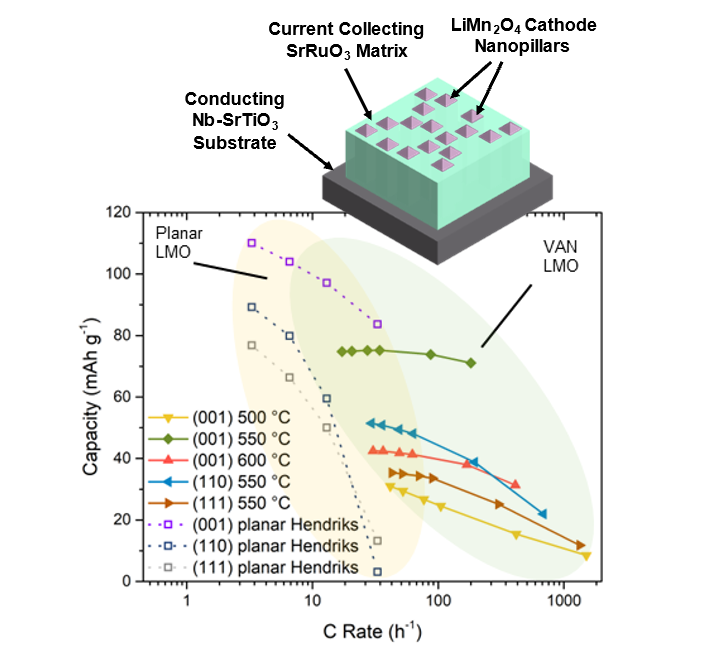High energy and high power density rechargeable micro-batteries are a necessity for powering the next generation of flexible electronics, internet of things, and medical technology devices. In theory, significant improvements in the capacity, current and power densities of micro-batteries would result if 3D architectures with enhanced interdigitated component interface areas and shortened ion diffusion path-lengths were used. Further gains are achievable if the materials utilized have high crystalline quality and are preferentially oriented for fast lithium intercalation.
In this work, this is achieved by creating epitaxial thin film cathodes comprised of nanopillars of LiMn2O4 (LMO) embedded in a supporting matrix of electronically conducting SrRuO3 (SRO). This VAN system takes advantage of its 3D architecture and nanometre diffusion path-lengths to enable remarkable high-rate performance, a requirement for fast charge capabilities. First, we demonstrate that our system shows clear, undisputable LiMn2O4 redox, the first and key demonstration for a battery VAN system comprised of solid-state battery materials. Then, we have shown how to achieve remarkable rate performances in thin film battery cathodes, with our optimised VANs achieving a discharge capacity > 70 mAh g-1 up to 180 C, significantly higher than both planar films and conventional battery cathodes which exhibit limited faradaic charge storage when cycled under similar high-rate conditions. The materials combination and self-assembled vertically aligned nanocomposite architecture are essential for these achievements. We were further able to elucidate that the LiMn2O4 nanopillar orientation and dimensions are integral to the achievable discharge capacities under high-rate regimes. Specifically, growing nanopillars preferentially orientated for fast lithium intercalation ((001) oriented) combined with finding the right balance between pillars with a high-volume percentage of active material (larger pillars) that can fully lithiate quickly under high-rate regimes (smaller pillars). Our work is not only important for understanding and overcoming limitations of current cathode materials but demonstrates an architecture that could be implemented in 3D thin film micro-batteries, thus enabling fast charging in < 10 seconds whilst retaining a significant discharge capacity.
Figure caption: Galvanostatic rate performance testing of LMO-SRO VAN films with schematic of VAN structure inset. Our optimised VAN, (001) SRO-LMO grown at 550 °C, achieves stable discharge capacities > 70 mAh g-1 up to 180 C, corresponding to 95 % capacity retention.
Lovett, A.J., Daramalla, V., Nayak, D., Sayed, F.N., Mahadevegowda, A., Ducati, C., Spencer, B.F., Dutton, S.E., Grey, C.P. and MacManus‐Driscoll, J.L., "3D Nanocomposite Thin Film Cathodes for Micro‐Batteries with Enhanced High‐Rate Electrochemical Performance over Planar Films", Advanced Energy Materials, 13(38) (2023) p.2302053

